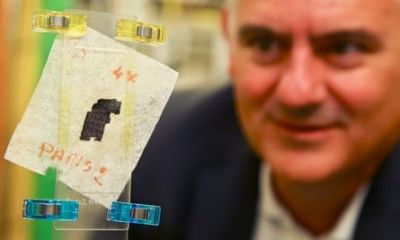When the blast from the eruption of Mount Vesuvius reached Herculaneum in 79 A.D., it burned hundreds of ancient scrolls to a crisp in the library of a luxury villa and buried the Roman town in ash and pumice. The disaster appeared to have destroyed the scrolls for good, but nearly 2,000 years later researchers have extracted the first word from one of the texts, using artificial intelligence to peer deep inside the delicate, charred remains. The discovery was announced on Thursday by Prof Brent Seales, a computer scientist at the University of Kentucky, and others who launched the Vesuvius challenge in March to accelerate the reading of the texts. Backed by Silicon Valley investors, the challenge offers cash prizes to researchers who extract legible words from the carbonized scrolls. “This is the first recovered text from one of these rolled-up, intact scrolls,” said Stephen Parsons, a staff researcher on the digital restoration initiative at the university. Researchers have since uncovered more letters from the ancient scroll. To launch the Vesuvius challenge, Seales and his team released thousands of 3D X-ray images of two rolled-up scrolls and three papyrus fragments. They also released an artificial intelligence program they had trained to read letters in the scrolls based on subtle changes that the ancient ink made to the structure of the papyrus. The unopened scrolls belong to a collection held by the Institut de France in Paris and are among hundreds recovered from the library at the villa thought to be owned by a senior Roman statesman, possibly Lucius Calpurnius Piso Caesoninus, the father-in-law of Julius Caesar. Two computer science students, Luke Farritor in Nebraska and Youssef Nader in Berlin, who took up the Vesuvius challenge, improved the search process and independently hit on the same ancient Greek word in one of the scrolls meaning “purple”. The race is now on to read the surrounding text. Dr Federica Nicolardi, a papyrologist at the University of Naples Federico II, said three lines of the scroll, containing up to 10 letters, were now readable with more expected to come.
Quando ci fu l'eruzione del Vesuvio nel 79 a.C., nell'antica città di Ercolano molte antiche pergamene furono bruciate. Le pergamene si trovarono nella biblioteca di una villa lussuosa. Nonostante il disastro ridusse tutte le pergamene in cenere, utilizzando un'intelligenza artificiale in grado di ricomporle, è stata scoperta una sola parola di un piccolo pezzo di cenere. La parola viene da una pergamena che ha più di 2.000 anni. I ricercatori sono riusciti a vedere la parola. La scoperta è stata annunciata in ottobre dal professor Brent Seales, professore dell'Università del Kentucky. Altri ricercatori che lavorano con lui in questo progetto stanno provando di non solo scoprire altre parole ma anche leggere le pergamene. Gli investitori della Silicon Valley offrono premi in denaro alle persone che riescono a trovare le parole nella cenere e a leggerle. Secondo Stephen Parsons, un ricercatore, ha detto che sono state trovate lettere ma non le parole complete. Seales ed i suoi colleghi hanno scattato migliaia di immagini a raggi X in 3D di due pergamene arrotolate e tre frammenti di papiro per contribuire a questa sfida. Ha anche creato un programma di intelligenza artificiale che può leggere le pergamene in base all'inchiostro anche se è in cenere. Le pergamene fanno parte di una collezione di un istituto di Parigi. La collezione ha circa un centinaio di ceneri di queste pergamene. Pensano che siano di Lucius Calpurnius Piso Caesoninus, suocero di Giulio Cesare. Due studenti di informatica, Luke Farrito del Nebraska e Youssef Neder di Berlino, che fanno parte di questo progetto, hanno trovato entrambi la parola che significa il colore viola. Questi studenti hanno fatto questa scoperta in modo indipendente e non hanno lavorato insieme. Ora c’è una corsa per leggere il testo attorno a questa parola. La dottoressa Federica Nicolardi, papirologa dell'Università di Napoli Federico II, ha detto che sono state scoperte tre file di pergamena, che contengono dieci lettere in totale, e stanno per riuscire nel leggere queste tre righe di testo.



